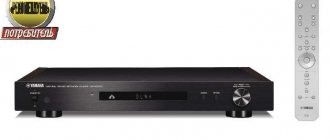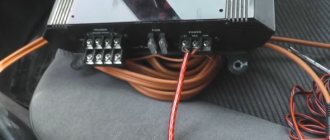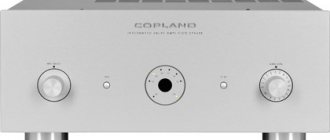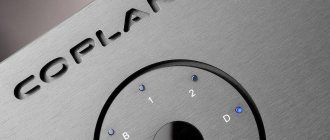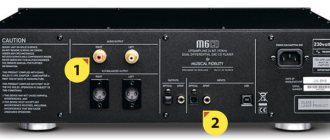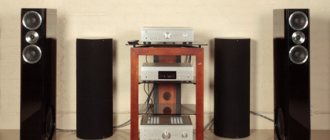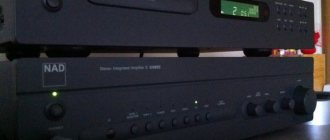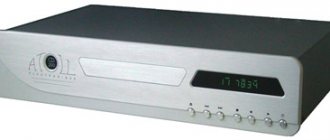Integrated amplifier TAC 34 Dream
If the creators called their model a “dream,” then this is either a pretentious marketing ploy, or something really serious. Considering that the dream was born in the TAC (Tube Amp Company) division of Vincent, a famous German High End manufacturer, there is every reason to believe that the TAC 34 Dream is a device worthy of attention. The design of the device is similar to a bread box. On a powerful metal chassis rises a monolithic body, whose facade is chrome-plated and polished to a mirror finish, as is the entire remaining upper part of the foundation. Under the casing there is a throttle-transformer unit. And the entire lamp arsenal is placed on the free part, covered with a round metal grille. The front side of the chassis is decorated with a thick plate of milled aluminum, into which the power switch is integrated and located in a separate rectangular compartment, also finished in chromed metal, an input selector and a volume control. The latter has a logarithmic construction. Black metal and mirror surfaces contrast very effectively. Two triplets of screw terminals for speaker cables allow the connection of speakers with different impedances. The two-stroke TAC 34 Dream in the final stage is served by four “Christmas trees” - EL34 pentodes. Pre-amplification is provided by four 6N3 dual triodes that support anti-phase voltage. I would also like to say about two 6E2 lamps, which are called the “magic eye”. These are indicator devices - the volume level is reflected in them on strips of phosphor, glowing with a pale emerald light, and it pulsates in time with the peak values. Such indicators were common in the middle of the last century. The entire internal installation of the amplifier is made using the classic hinged method, except for the only board on which ceramic panels for lamps are installed. It is better to spend a little more time warming up the device before each listening than is recommended in the user manual, but 10-15 minutes will be enough. A positive feature of the device is the model’s ability to work with absolutely any genre. It is indeed quite rare to listen to such a device. He is capable of bursting, screaming, incinerating everything around with the most powerful riffs of rampaging electric guitars, attacks in the bass sections or cannonades of percussion instruments, accompanied by piercing vocals. But after changing the medium, it suddenly becomes gentle, meek and pacifying, delicately conveys chamber classical music, lulls, relaxes, bringing to the listener the whole lively atmosphere of an elite concert hall, where well-deserved and recognized works of past centuries are performed. And what a treat for jazz fans who began their education with ragtime, New Orleans sing-song ballads, gospel, swing, bebop and then learned the mainstream, the music of big bands, the kings of jazz-rock and the heroes of Broadway musicals. The unevenness of the amplitude-frequency response of the TAC 34 amplifier in the audio frequency band is very low - 0.24 dB. Subsequently, a strong decline is also not detected in the supra-tonal region, and the passband at the –3 dB level lies, as we see it, still above 100 kHz. The imbalance between channels is within 0.5 dB. Output power at 10% distortion is 53 W into 8 ohms. With an amplifier output power of less than 2 W, the nonlinear distortion factor drops below 1%, and at 1 W it takes a value of 0.66%. The 96 dBA signal-to-noise ratio demonstrated by the TAC 34 Dream amplifier is a good indicator for tube technology. The same can be said about the amount of signal interference between channels - 52 dB at a frequency of 10 kHz.
TAC 34 Dream
The German company Vincent and its division TAC (Tube Amp Company) have released the TAC 34 Dream integrated tube amplifier. And, apparently, it was not without reason that they gave it the name “dream”. You can really dream about such a device. You want to admire the design, jokingly called by the people as a bread box, without turning on the soundtrack. The massive metal chassis is divided into two parts: at the back there is a reliable casing that covers the transformers and inductor, and a little more than the front half is covered with a mirror chrome plate, on which, in fact, the heroes of the occasion are mounted - radio tubes of selected quality. The top and sides of these fragile devices are protected by a reliable semicircular metal grille (which, by the way, can be removed if, for example, you need to replace the lamps or remove dust from them). On the facade there are modestly located a power switch and two round knobs located on the right, in a rectangular recess with a chrome surface - a logarithmic volume control and an input selector. At the back there are four stereo RCA input pairs and two triplets of screw terminals for connecting speakers with a resistance of 4 or 8 Ohms. The amplifier circuit is push-pull, using four EL34 pentodes. The preliminary stage in both channels is served by four double 6N3 triodes - they monitor the anti-phase voltage, which affects the power of the final stage. The highlight of the lamp industry is two power indicators (6E2 “Magic Eye”), on whose bulbs vertical strips of phosphor are applied, which pulsate with a greenish-milky color, evoking a feeling of nostalgia for bygone years. What we somewhat disagree with is the manufacturer’s assurances that warming up the amplifier for two minutes will be enough. This may indicate that it goes on sale having been run-in at the factory, but we recommend warming it up for at least 10 minutes before each use. By the way, the lamps used here make absolutely no noise, even at maximum volume. In Megadeth's furious and crushing opus, the amplifier produced a completely solid, dense and textured picture, flooded with energy and drive, and at the same time freed our ears from ringing, confusion and sibilance at high frequencies. But the bass moved forward and became more tangible. In contrast, we listened to several soft pop numbers (Kari Bremnes) and ballad recitatives by Leonard Cohen. The tube soul of the TAC 34 Dream imbued these compositions with true analog warmth. At the same time, we did not catch a hint of softness or cottoniness - the detail and clarity of the sound remained excellent. Pop rock followed. Naturally, we started with the owners of multifaceted musical talents - the Beatles, then we recharged ourselves with the elastic rhythms and melodies of Donna Summer, then we rode the “new wave” with the trio A-Ha - and realized that in such major styles there is at least something to complain about. or to the amplifier is impossible. A walk through jazz themes enhanced the euphoric effect, after which, after appreciating Chopin’s piano nocturne performed by Naum Starkman, we moved on to Dunaevsky and listened to his epochal suite “The Children of Captain Grant” performed by the Russian Symphony Orchestra of Mark Gorenstein. And every time the details and all the nuances were drawn out delicately and professionally. And now the most important thing. Everything we have just said concerns the operation of the TAC 34 Dream in conjunction with a CD player, that is, the playback of media with a somewhat digital nature. This suggests that the amplifier definitely has a beneficial effect on the sound, ennobling it, as was intended when creating tube technology.
Integrated amplifier VINCENT TAC -34 Dream
Integrated tube amplifier, pre-tubes: 2x 6E2, 2x6E2 “Magic Eye”, output: 4xEL34, output power: 2x50 W, frequency range: 20 Hz - 40 kHz (+/-1.5 dB), signal-to-noise ratio : 95 dB, distortion factor: 1% switching: 4 x RCA, dimensions 420 x 210 x 270 mm, weight: 19 kg, color options: black, silver.
Specifications
| Are common | |
| Name | VINCENT TAC -34 Dream |
| Manufacturer | VINCENT (Germany) |
| Series | TAC |
| Device type | Integrated amplifier |
| Supply voltage, V | 230 V / 50 Hz |
| Dimensions, mm | 420 x 210 x 270 |
| Weight, kg | 19 |
| Guarantee | 12 months |
| Main characteristics | |
| Number of channels | 2 |
| Power 8 Ohm, W | 2 x 40 |
| Power 4 Ohm, W | 2 x 40 |
| Frequency range, Hz-kHz | 20 - 60 (+/-1.5 dB) |
| S/N ratio, dB | 95 |
| Lamp equipment | 4 x EL34B, 2 x 6E2, |
| Connector input | |
| Analog audio | 4 x RCA |
| Connectors output | |
| Analog audio | 1 x RCA |
| Acoustic | 2 x 3 (4 and 8 ohms) |
The German company Vincent and its division TAC (Tube Amp Company) have released the TAC 34 Dream integrated tube amplifier. And, apparently, it was not without reason that they gave it the name “dream”. You can really dream about such a device. You want to admire the design, jokingly called by the people as a bread box, without turning on the soundtrack. The massive metal chassis is divided into two parts: at the back there is a reliable casing that covers the transformers and inductor, and a little more than the front half is covered with a mirror chrome plate, on which, in fact, the heroes of the occasion are mounted - radio tubes of selected quality. The top and sides of these fragile devices are protected by a reliable semicircular metal grille (which, by the way, can be removed if, for example, you need to replace the lamps or remove dust from them). On the facade there are modestly located a power switch and two round knobs located on the right, in a rectangular recess with a chrome surface - a logarithmic volume control and an input selector. At the back there are four stereo RCA input pairs and two triplets of screw terminals for connecting speakers with a resistance of 4 or 8 Ohms. The amplifier circuit is push-pull, using four EL34 pentodes. The preliminary stage in both channels is served by four double 6N3 triodes - they monitor the anti-phase voltage, which affects the power of the final stage. The highlight of the lamp industry is two power indicators (6E2 “Magic Eye”), on whose bulbs vertical strips of phosphor are applied, which pulsate with a greenish-milky color, evoking a feeling of nostalgia for bygone years.
What we somewhat disagree with is the manufacturer’s assurances that warming up the amplifier for two minutes will be enough. This may indicate that it goes on sale having been run-in at the factory, but we recommend warming it up for at least 10 minutes before each use. By the way, the lamps used here make absolutely no noise, even at maximum volume.
In Megadeth's furious and crushing opus, the amplifier produced a completely solid, dense and textured picture, flooded with energy and drive, and at the same time freed our ears from ringing, confusion and sibilance at high frequencies. But the bass moved forward and became more tangible. In contrast, we listened to several soft pop numbers (Kari Bremnes) and ballad recitatives by Leonard Cohen. The tube soul of the TAC 34 Dream imbued these compositions with true analog warmth. At the same time, we did not catch a hint of softness or cottoniness - the detail and clarity of the sound remained excellent. Pop rock followed. Naturally, we started with the owners of multifaceted musical talents - the Beatles, then we recharged ourselves with the elastic rhythms and melodies of Donna Summer, then we rode the “new wave” with the trio A-Ha - and realized that in such major styles there is at least something to complain about. or to the amplifier is impossible. A walk through jazz themes enhanced the euphoric effect, after which, after appreciating Chopin’s piano nocturne performed by Naum Starkman, we moved on to Dunaevsky and listened to his epochal suite “The Children of Captain Grant” performed by the Russian Symphony Orchestra of Mark Gorenstein. And every time the details and all the nuances were drawn out delicately and professionally. And now the most important thing. Everything we have just said concerns the operation of the TAC 34 Dream in conjunction with a CD player, that is, the playback of media with a somewhat digital nature. This suggests that the amplifier definitely has a beneficial effect on the sound, ennobling it, as was intended when creating tube technology.
